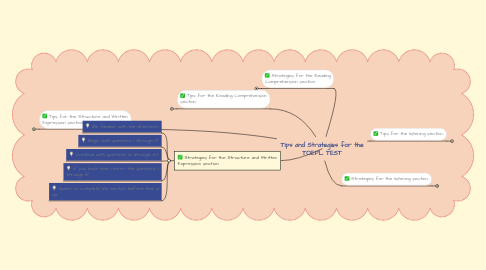Tips and Strategies for the TOEFL TEST
作者:Gloria Funes

1. Tips for the Structure and Written Expression section:
1.1. First study the sentence.
1.2. Then study each answer based on how well it completes the sentence.
1.3. Never leave any answers blank.
1.4. Do not spend too much time on the Structure questions.
2. Strategies for the Structure and Written Expression section:
2.1. Be familiar with the directions.
2.2. Begin with questions 1 through 15.
2.3. Continue with questions 16 through 40.
2.4. If you have time, return the questions 11 through 15.
2.5. Guess to complete the section before time is up.
3. Tips for the Reading Comprehension section:
3.1. For main idea questions. look at the first line of each paragraph .
3.2. For vocabulary questions. the vocabulary will be highlighted in the passage .
3.3. For insertion questions. look at the context before and after each insertion box.
3.4. Read the part of the passage that contains the answer carefully. The answer will probably be in a very predictable place in the passage.
4. Strategies for the Reading Comprehension section:
4.1. Be familiar with the directions. The directions on every computer TOEFL test are the same. So it is not necessary to spend time reading the directions carefully when you take the test. You should be completely familiar with the directions before the day of the test.
4.2. Do not spend too much time reading the passages. You do not have time to read each passage in depth. and it is possible to answer the questions correctly without first reading the passages in depth. You must scroll through each passage completely and then click on ‘proceed’ before you will be allowed to continue with the questions.
4.3. Monitor the time carefully on the title bar of the computer screen. The title bar indicates the time remaining in the section, the total number of questions in the section, and the current number.
4.4. Guess to complete the section before time is up. Because this section is linear rather than adaptive, it can only increase your score to guess the answers to questions that you do not have time to complete.
5. Tips for the listening section:
5.1. As you listen to each short conversation, focus on the second line of the conversation.
5.2. Keep in mind that the correct answer is probably a restatement of a key word or idea in the second line of the conversation.
5.3. Keep in mind that certain structures and expressions are tested regularly in Listening part A.
5.4. Keep in mind that these questions generally progress from easy to difficult.
5.5. Read the answers and choose the best answer to each question. Remember to answer each question even if you are not sure of the correct response.
5.6. Even if you do not understand the complete conversation, you can find the correct answer.
5.7. Never choose an answer because it sounds like what you heard in the conversation.
6. Strategies for the listening section:
6.1. Be familiar with the directions.
6.2. Listen carefully to the conversations and talks.
6.3. Know where the easier and more difficult questions are generally found.
6.4. Never leave any questions blank on your answer sheet.
6.5. Use any remaining time to look ahead at the answers to the questions that follow.


